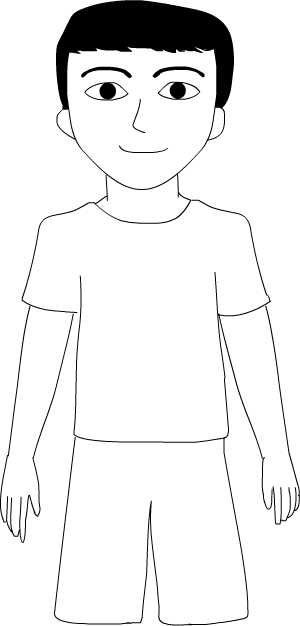TSL Online Dictionary
© 2025 The Taiwan Center for Sign Linguistics, National Chung Cheng University. All Rights Reserved.
Taiwan Sign Language (TSL) is the language used by the Deaf in Taiwan and is genetically related to Japanese Sign Language (JSL), which was brought to Taiwan by deaf educators during Japanese occupation of Taiwan in 1895-1945. After 1949, Chinese Sign Language (CSL) was brought to Taiwan. Therefore, some signs from CSL may also have been integrated into TSL. Recently, there have been many new signs that have been created with the times.
The compilation of the Taiwan Sign Language Online Dictionary was under the supervision of Prof. Jane Tsay and Prof. James H.-Y. Tai. The sign language research team of the Linguistics Institute at the National Chung Cheng University started the construction of the TSL Online Dictionary in 2001 with the supports from National Science Council, Taiwan. In the dictionary, each lexical item is linked to the video of the TSL sign. The dictionary is bilingual in the sense that all lexical items (signs) and the description of the signs have both Chinese and English translations (see Tsay 2019 for more details).
Tsay, Jane. 2019. Taiwan Sign Language Online Dictionary: Construction and Expansion. In the Proceedings of the 2nd ILAS Annual Linguistics Forum- National Language Corpora: Design and Construction, 85-110. Taipei: Institute of Linguistics, Academia Sinica. (pdf)
The current edition of the TSL Online Dictionary (4th English edition released in 2022) contains about 3700 lexical items and 560 illustrating sentences for high frequency words. The lexical items also contain their dialectal and/or free variations. Information of synonym and polysemy of each lexical item is also provided. Phonological annotations of handshape and location of all lexical items has been added to this fourth edition of TSL Online Dictionary and thus extended the dictionary to a phonologically annotated corpus. The TSL Online Dictionary serves as a base for inquiries in both linguistic research and practical usage. For teachers in deaf education or the general public, this dictionary is a tool for teaching or learning TSL. For researchers who are interested in the linguistic structure of TSL, the dictionary provides data for analysis in phonology, morphology, semantics, and syntax. With its being bilingual, the dictionary also provides bases for cross sign language comparisons for international scholars.
Citing:
Tsay, Jane, James H.-Y. Tai, Shih-kai Liu and Yijun Chen. 2022.Taiwan Sign Language Online Dictionary. 4th English Edition.
Chiayi: The Taiwan Center for Sign Linguistics, National Chung Cheng University, Taiwan.
http://twtsl.ccu.edu.tw/TSL/en.php
Programming:
Chun I Chen of Department of Information Management, National Chung Cheng University.
Please read the User's Guide before you use the dictionary. Your comments and suggestions will be highly appreciated. Please contact the webmaster at lngsign@ccu.edu.tw
Grants from the National Science Council, Taiwan: A Study of Taiwan Sign Language: Phonology, Morphology, Syntax and Digital Graphic Dictionary (NSC90-2411-H-194-025, NSC91-2411-H-194-002, NSC92-2411-H-194-001, NSC93-2411-H-194-001). The Taiwan Center for Sign Linguistics is responsible for the maintenance and expansion of the dictionary.
Consultants:
Mr. Yushan Gu, a former chairman of the Taiwan Association for the Deaf Sign linguistic researchers:
Gladys Tang, Jean Ann, Susan Fischer, Scott Liddell, Wayne Smith, and Qun-hu Gong.
Demonstrators:
Mr. Yushan Gu
Yuyi Chen, a Deaf graduate student of the Institute of Linguistics of National Chung Cheng University.
Interpreter:
Mrs. Yue-xia Xiao
Research assistants over the years:
Shuping Gong, Hsin-Hsien Lee, Shiou-fen Su, Meylysa Tseng, Hui-juan Liu, Ya-Ching Tsou, Yan-An Lee, Pei-lan Wu,
Yi-Hsien Lee, Yi-jun Chen, Ming-xiu Huang, Yi-ling Wu, Xin-hui Chen, Shi-kai Liu, Yu Hong, Chang-yu Wu, Xiu-qing Lin,
Ya-jiun Tseng, Zhi-ren Zheng, Guan-nan Jiang, and Wan-yu Liu.
User's Guide
- This online dictionary supports Google Chrome, Firefox, and Safari browser.
- You can search for a sign by 'English Search' or 'Features of TSL'. English Search contains 'Keyword Search' and 'Location Search' and Features of TSL contains 'Handshape Search' and 'Location Search'. Click here for guides for searching.
- Every entry contains a video clip, pictures of the handshape and locations, and some entries contain examples of sentences. If an entry is polysemous or synonymous, its polysemy and synonymy are also listed.
- Each video clip offers three types of playing speed for TSL learners: normal speed, 1/2 normal speed and 1/4 normal speed.
- Some TSL signs have dialectal variations. N and S stand for the northern and southern Taiwan variants, respectively. For example, when you search the word ABLE, you will see ABLE_N and ABLE_S for the two variations.
- Besides the aforementioned dialectal variations, some TSL entries have other free variations. For example, when you search the word PERSON, you will see PERSON _A and PERSON _B. This means that the word PERSON has two variants, which are not dialectal variations but a single sign with different variants. We list the variants according to their frequencies, with the A variant being the most frequent, and the B, C, D variants being less frequent.
Guide of searching function
-
Keyword Search:
Type your target word in the 'Search' at the right of the window and click on the button 'Submit'. -
Alphabet Search:
Use the first alphabet of the target word for search. Then the entries will be listed on the right of the window. You can click on the entries to view video clips. -
Handshape Search:
First, click on the 'Handshape Search' at the right of the window. Next, choose the handshape of the sign, and the location. Then, the entries will be listed. You can also click on 'All of the entries' for the entries. Click here for Guide for using Handshape Search. -
Location Search:
Users can use the location of a sign for search. Click on the 'Location Search' first. Next, click on the picture of the location of the sign. Then, click on the picture of the handshape, and the entries will be listed. Click here for Guide for using Location Search.
-
To search the handshape more quickly, handshapes are categorized by the number of fingers. Except for signs with four fingers and a thumb, which open or close together, the number of the fingers is counted based on the number of extending fingers.
For example,/
 / is signed by extending the index finger and middle finger, so the handshape /
/ is signed by extending the index finger and middle finger, so the handshape /  / is used for searching.
/ is used for searching.
-
Some handshape have two or three variants. The difference lies on the extending or bending knuckles. For example,/
 /has three variations:
/
/has three variations:
/  /,/
/,/  /,and /
/,and /  /.
Click /
/.
Click /  /for the variations.
/for the variations.
-
If a sign is one-handed sign, please search with the handshape of the dominant hand. For example, ONE is signed by extending the index finger in front of the body, so the handshape /
 / is used for searching.
/ is used for searching.
- Two-handed signs:
-
If both hands have the same handshape, whether both hands are moving or still at the same time, use the handshpe for search. For example, PLAY is signed by extending the index fingers of both hands above shoulders,
so please choose /
 / for searching.
/ for searching.
-
If both hands have different handshapes, whether both hands are moving or still at the same time, either handshape can be used for search. For example, BIRD is signed by closing the thumb and the index finer repeatedly in front of the mouth,
with the other hand moving up and down repeatedly, so either the handshape /
 / or /
/ or /  / can be used for searching.
/ can be used for searching.
-
If one hand stays still while the other is moving, whether both hands have the same handshape, use the handshape of the moving hand for search. For example, SHRIMP is signed by curving the index finger of one hand repeatedly on the back of the other hand, so the handshape
/
 / is used for searching.
/ is used for searching.
Guide for Location Search
- If a sign is one-handed sign, use the location of the dominant hand for search. For example, ONE is signed by extending the index finger in front of the body, so the location 'in front of body' is used for searching.
- Two-handed signs:
- If both hands are at the same location, whether both hands are moving or stay still at the same time, the location is used for search. For example, PLAY is signed by extending the index fingers of both hands above shoulders, so the location 'head' is used for searching.
- If both hands are at different locations, whether both hands are moving or still at the same time, the location of either hand can be used for search. For example, BIRD is signed by closing the thumb and the index finer repeatedly in front of the mouth, with the other hand moving up and down repeatedly, so either the location 'mouth' or 'in front of body' can be used for searching.
- If one hand stays still while the other is moving, whether both hands have the same location, use the location of the moving hand for search. For example, SHRIMP is signed by curving the index finger of one hand repeatedly on the arm other hand. So, the location 'arm' is used for searching instead of 'in front of body'.
Handshapes are categorized by the number of fingers. Some handshapes have two or three variants shown as small picture.
One Finger |
|||||||
|---|---|---|---|---|---|---|---|
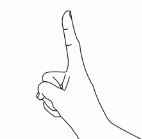
|

|
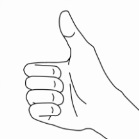
|

|

|
|||

|
 |
 |
 |
||||
Two Fingers |
||||||||
|---|---|---|---|---|---|---|---|---|
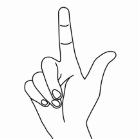
|
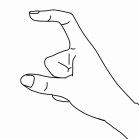
|

|

|

|
||||
|
|
||||||||

|

|

|
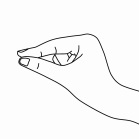
|
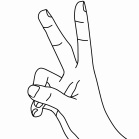
|
||||
|
|
||||||||
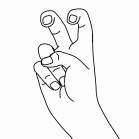
|
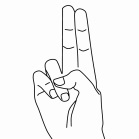
|
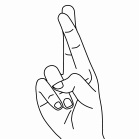
|
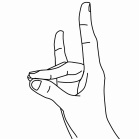
|
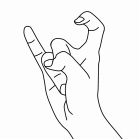
|
||||
|
|
||||||||
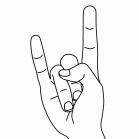
|
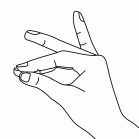
|
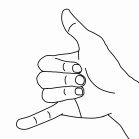
|
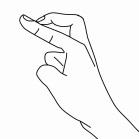
|
|||||
|
|
||||||||
Three Fingers |
|||||||
|---|---|---|---|---|---|---|---|
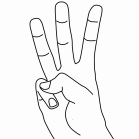
|

|
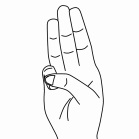
|
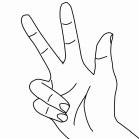
|

|
|||

|
 |
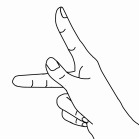 |
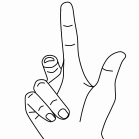
|
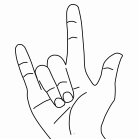 |
|||
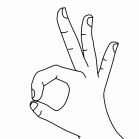
|
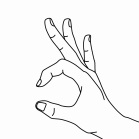 |
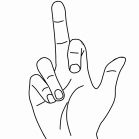
|
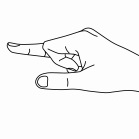
|
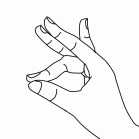 |
|||
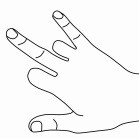
|
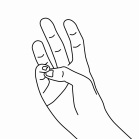
|
||||||
Four Fingers |
||||
|---|---|---|---|---|
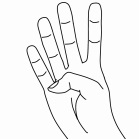 |

|

|

|

|
 |
||||
Five Fingers |
|||||||
|---|---|---|---|---|---|---|---|
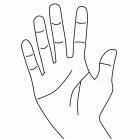
|

|
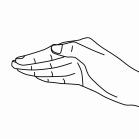
|

|
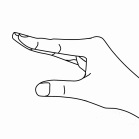 |
|||
|
|
|||||||
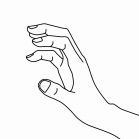
|
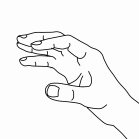
|
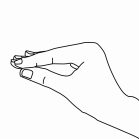
|
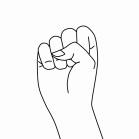
|
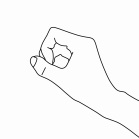
|
|||
|
|
|||||||
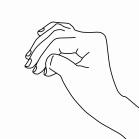
|
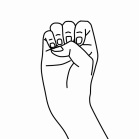
|
||||||
The locations of most common used are as follows.
 |
 |
 |
 |
 |
| Forehead | Temple | Eyes | Nose | Ears |
 |
 |
 |
||
| Cheek | Mouth | Chin |
 |
 |
 |
| Lower Face | In Front of Face | Head |
 |
 |
 |
 |
 |
| Neck | Shoulders | Chest | Abdomen | Waist |

|
||||
| Legs |
 |
 |
 |
| In Front of Body | Back | Both Sides of Body |
 |
 |
 |
 |
 |
| Lower Arm | Upper Arm | Arm | Elbow | Fingers |
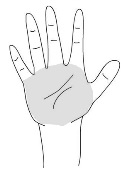 |
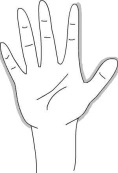 |
 |
 |
 |
| Palm | Blades of Hand | Back of Hand | Hand | Wrist |
